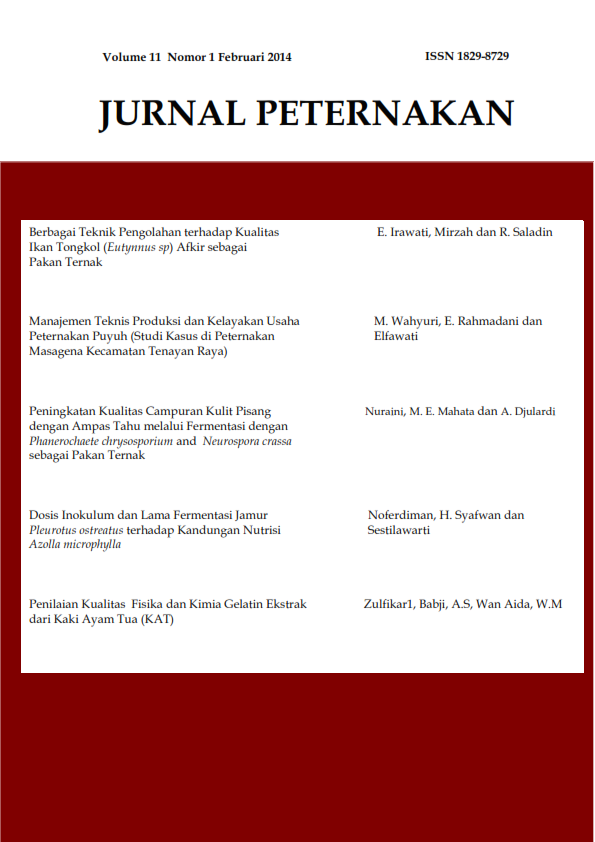PENINGKATAN KUALITAS CAMPURAN KULIT PISANG DENGAN AMPAS TAHU MELALUI FERMENTASI DENGAN Phanerochaete chrysosporium DAN Neurospora crassa SEBAGAI PAKAN TERNAK
DOI:
https://doi.org/10.24014/jupet.v11i1.2324Keywords:
Banana peel, tofu waste, Phanerochaete chrysosporium, Neurospora crassaAbstract
Banana peel can be used as an alternative feed based on the potential availability and nutritional. The experiments were conducted to improve the nutrient quality of Banana Peel and Tofu Waste mixture (BPTW) by using Phanerochaete chrysosporium and Neurospora crassa. This substrate consists of banana peel 70% and tofu waste 30%. The experiment was performed in 3 treatment completely randomized design (CRD) with 6 replicates. The treatments were : A= fermentation BPTW by Phanerochaete chrysosporium and Neurospora crassa (1:1), B = fermentation BPTW by Phanerochaete chrysosporium and Neurospora crassa (2:1), and C = fermentation BPTW by Phanerochaete chrysosporium and Neurospora crassa (1:2). Measured variables were Crude Fiber (CF), Crude Protein (CP), Nitrogen Retention and CF digestion. The result of the research showed that the treatment affected significantly (p<0.01) reduced CF and increased CP, nitrogen retention and CF digestion. In conclusion, fermentation by Phanerochaete chrysosporium and Neurospora crassa (2:1) was the best treatment for improving banana peel and tofu waste nutrient qualityDownloads
Published
Issue
Section
License
The Authors submitting a manuscript do so on the understanding that if accepted for publication, copyright of the article shall be assigned to Jurnal Peternakan and published by Fakultas Pertanian dan Peternakan Universitas Islam Negeri Sultan Syarif Kasim Riau as publisher of the journal.
Authors who publish with this journal agree to the following terms:
Authors automatically transfer the copyright to the journal and grant the journal right of first publication with the work simultaneously licensed under a Creative Commons (CC BY) that allows others to share the work with an acknowledgement of the work's authorship and initial publication in this journal.
Authors are able to enter into separate permission for non-exclusive distribution of the journal's published version of the work (e.g., post it to an institutional repository or publish it in a book), with an acknowledgement of its initial publication in this journal.
Authors are permitted and encouraged to post their work online (e.g., in institutional repositories or on their website) prior to and during the submission process, as it can lead to productive exchanges, as well as earlier and greater citation of published work (See The Effect of Open Access).

